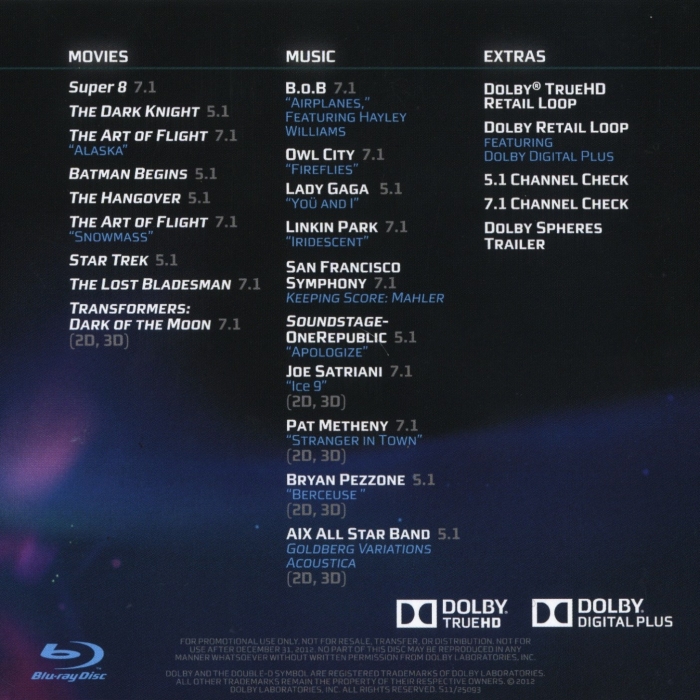
- #DOLBY ATMOS DEMONSTRATION DISC AUGUST 2014 MOVIE#
- #DOLBY ATMOS DEMONSTRATION DISC AUGUST 2014 DRIVERS#
- #DOLBY ATMOS DEMONSTRATION DISC AUGUST 2014 FULL#
I allowed the Denon’s excellent Audyssey Platinum/MultEQ XT32 to handle the setup, including the height speakers (but I confirmed channel levels manually).

My listening to the jury-rig over my own speakers quickly persuaded me that when you hear a properly set-up Atmos system for the first time, you won’t harbor much doubt as to the difference.
#DOLBY ATMOS DEMONSTRATION DISC AUGUST 2014 FULL#
Late in the game, through the good offices of Paramount Home Media, I received a pre-release full copy of Transformers: Age of Extinction, announced as the very first Atmos title to be released to the wild.Īll this, of course, is merely preliminary to what you really want to know: Just how does Atmos, here and now, sound? Pretty damned good, is the short answer.
#DOLBY ATMOS DEMONSTRATION DISC AUGUST 2014 MOVIE#
This limited our test material to Dolby’s August, 2014 Atmos Demonstration Disc, a collection of Atmos trailers, two movie scenes, and a music video. The slanted baffles on the rear Atmos speakers fired toward the front of the room, angled slightly inward to mimic the angle they’d see if they’d been mounted on toed-in rear speakers.Ītmos-encoded programming will be available, initially at least, only via Blu-ray Disc, though some streaming sources should quickly follow. I ended up dropping the front modules right on top of the Veritas mains and placing the “back” modules on the sidewall shelves, right alongside my existing dipole surrounds, at approximately 4 feet from the ceiling. Making this work required nothing more exotic than a few temporary, stick-on rubber feet, from among the hundreds I’ve, err, collected from review samples over the years. (Pioneer, Atlantic Technology, Integra, KEF, Onkyo, and Yamaha have also debuted Atmos-ready speakers or electronics, with more doubtless to follow.)īut since we also wanted to learn how adaptable Atmos might be, I tried the A60 modules in unsanctioned duty (sorry, Def Tech!) atop my long-term speakers: Energy Veritas three-way, stand-mount monitors up front and dipole surrounds in back. It’s a damned slick system, and the end result looks exactly like it came from the factory that way. These loaf-sized, up-firing cabinets cleverly snap into place atop the BP-8060STs, once each tower’s top panel is removed from its plastic “popper” pegs. To find out just how well this works, we rounded up one of the first-possibly the first-home theater Atmos systems: a Denon AVR-X5200 Atmos receiver and a quartet of Definitive Technology’s BP-8060ST powered towers ($999 each), each equipped with Def Tech’s new model A60 Atmos Elevation Module ($499/pair).
#DOLBY ATMOS DEMONSTRATION DISC AUGUST 2014 DRIVERS#
These drivers can either be built into the top of a traditional box loudspeaker or added on with dedicated Dolby-enabled modules that rest atop an existing speaker. Their up-firing drivers are angled such that their output-much of it, anyway-will reflect from a smooth, flat ceiling surface such as typical sheetrock or plaster, from roughly the same locations suggested by Dolby’s layout guides for ceiling speakers (which can now be found online at ). Fortunately, Dolby and speaker-makers have cooked up a solution: upward-firing speaker modules, so-called “Dolby-enabled speakers,” sited atop the front left/right and surround speakers. While ceiling speakers are the obvious answer for new construction of dedicated home theaters and media rooms, most retrofitters are understandably reluctant to deploy the hole-saw overhead. Atmos can also accommodate 7.1.4 and 9.1.2 layouts (with an 11-channel AVR) and could conceivably evolve to even more channels remember, it’s scalable. But 5.1.4 is said to be optimal and can be driven by a nine-channel receiver without requiring outside amplification. A 5.1.2 layout, with front-position Dolby-enabled speakers (see below) or a pair of ceiling speakers to the left/right of the listening position, is also sanctioned. But Atmos is scalable: A commercial theater can have as many as 64 discrete, individually addressable loudspeakers, including multiple “height” speakers in the ceiling.Īt home, this translates to a recommendation of ideally four additional speakers at the minimum: left/right “height” pairs, both front and rear, an arrangement Dolby refers to as 5.1.4 channels. Ultimately, of course, whether at the theater or at home, sounds still emanate from physical loudspeakers driven by physical amplifier channels, so there’s a certain amount of semantics at play here.

Briefly, then, object-oriented means that instead of panning discrete effects or overall mixes to left, center, right, or various surround channels, sound designers and producers can now direct sounds through a virtual listening space, letting the computer work out the details. Dolby Atmos, the latest, “object-oriented” surround sound solution magicked up by the San Francisco technologists, has earned enough ink here and elsewhere that many of us are passingly familiar with it already.


 0 kommentar(er)
0 kommentar(er)
